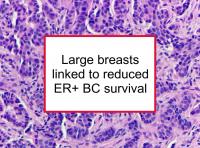Large breast size is associated with heightened breast cancer risk. While it is well established that large areas of dense breast tissue increases breast cancer risk, the link is less clear for large areas of primarily fatty tissue. Breast reduction surgery has been found to reduce the risk of breast cancer.
Now a new study has reported that large breast size is associated with reduced breast cancer survival in women with estrogen receptor positive (ER+) breast cancer.
Relationship between weight, large breasts and breast cancer risk
Large breasts in lean women have somewhat different breast cancer risk implications than large breasts in overweight women. Generally speaking, obesity is protective in premenopausal women, for reasons that are not clear. Therefore, younger women who have large breasts primarily as a result of being very overweight do not have a heightened risk of breast cancer.
However, thin or normal weight premenopausal women with large breasts have been found to have increased breast cancer risk. One study found that a large bra cup size at a young age was associated with a higher risk of premenopausal breast cancer, but only for leaner women with body mass index (BMI) under 25.
On the other hand, for postmenopausal women, breast cancer risk increases with increasing BMI. As a result, postmenopausal women with large breasts have a heightened risk of breast cancer whether or not they are overweight.
Latest research finds large breast size associated with poorer prognosis
The study referenced at the beginning of this news article was designed to investigate whether breast size influences breast cancer-free survival. Since body mass index and waist-to-hip ratio (in addition to tumor characteristics) are known to affect breast cancer outcomes, the authors sought to determine whether large breast size influences disease-free survival independently of these factors.
The study included 772 Swedish breast cancer patients, from whom body measurements were taken before surgery. Breast volumes were measured with plastic cups used by plastic surgeons doing breast reductions. Additional data was obtained from medical records.
Overweight and obese (BMI ≥ 25 kg/m2) women were found to have larger tumors and more positive axillary lymph nodes than normal weight and underweight women. In addition, women with a waist-to-hip ratio over 0.85 had larger tumors, higher grade tumors, and more positive lymph nodes. Women with large breasts (total breast volume ≥ 850 mL) were also more likely to have larger tumors, higher grade tumors, and more positive lymph nodes.
The women were followed for seven years, during which time there were 62 breast cancer recurrences. Large breast volume was found to be associated with shorter breast cancer-free survival and distant metastasis-free survival in women with ER+ tumors independent of BMI, waist-to-hip ratio, and age. In fact, breast size was a strong independent predictor of shorter disease-free and distant metastasis-free survival in ER+ patients, adjusted for tumor characteristics, BMI, age, and treatment.
The authors conclude that simple and cheap body measurement with standardized tools might help identify a subgroup of patients in need of tailored breast cancer treatment.
Please see our articles on breast reduction surgery and ER+/PR+ breast cancer for more information.
